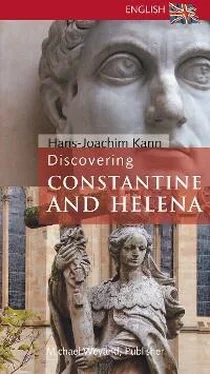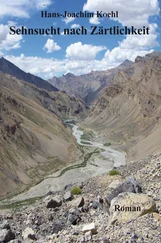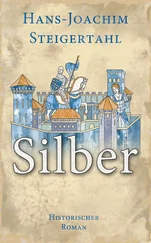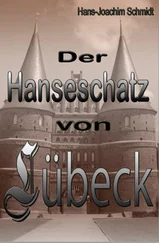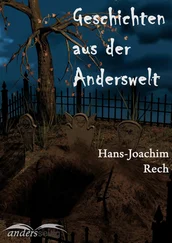Verlag Michael Weyand
Hans-Joachim Kann
*
DISCOVERING CONSTANTINE AND HELENA IN TRIER
*
Publisher
© Michael Weyand, Inc, Trier, www.weyand.de
All rights reserved
Photos: Josef Tietzen, Gabriela Böhm, Michael Weyand, Alexander Kann,
Rheinisches Landesmuseum, The photos on pages 19, 27, 29, 31, 32
(right), 46 (left), and on the back cover (top) were reproduced with the kind permission of the Bishop’s Museum, Trier
Design: Sabine König
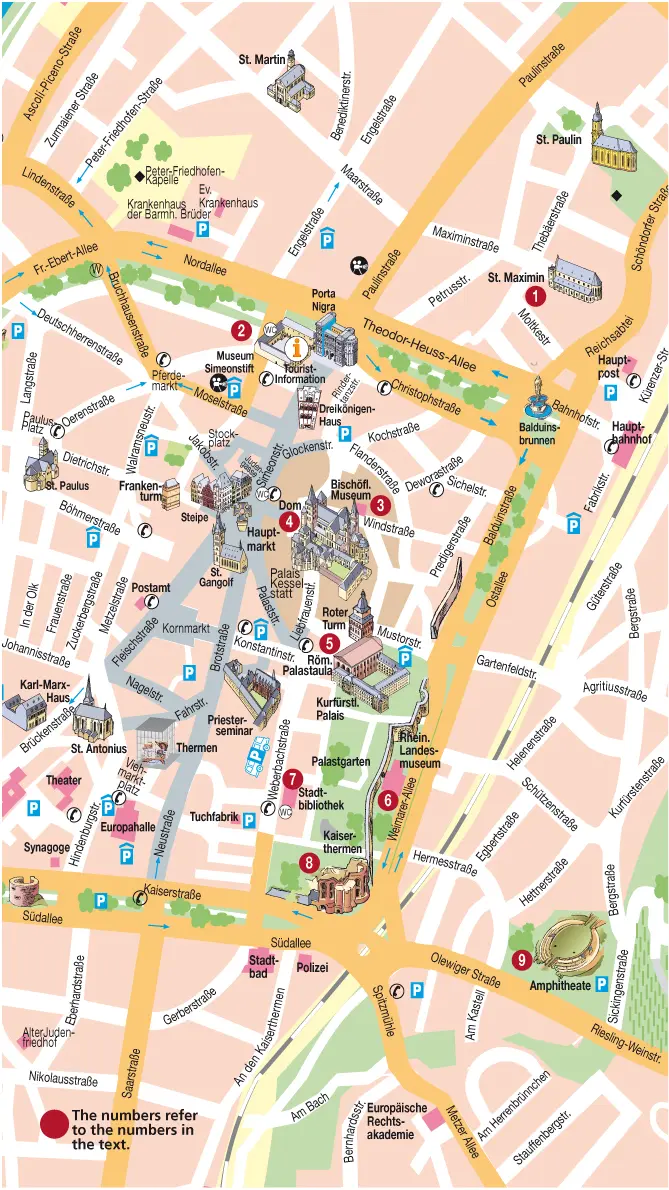
Discovering Constantine and Helena in Trier
What do the following all have in common: the word “soldier“, the city name Istanbul, Sunday as a day of rest, the location of the Church of the Holy Sepulcher in Jerusalem, “of one Being with the Father” in the Nicene Creed? Or the Chi Rho (XP, the first two letters of “Christ”), the location of the Hagia Sophia or St. Peter’s in Rome, but also of the largest Christian church from Antiquity, the then Trier Cathedral? What do an arch and a donation have in common?
They all go back to Constantine.
But what does Constantine have to do with Trier?
Trier was the residence of his father, Constantius Chlorus, from AD 293 to 306 and was Constantine’s residence from 306 to 312. It was his preferred place to stay up to 316. He probably visited in 321 and certainly in 328, perhaps even up to the spring of 329.Trier was the residence of his mother, the Dowager Empress Helena.
Both have left their traces in Trier.
Let us follow in their footsteps.
Trier’s history before Constantine and Helena
Following Julius Caesar’s conquest of Gaul between 58 and 50 BC, the territory of the Celtic Treveri between the Moselle, Nahe, and Rhine was integrated into the Roman Empire but not developed. It was the plan for a highway from Marseille on the Mediterranean via Lyon to as far as the Rhine that led to the building of a wooden bridge across the Moselle in 18/17 BC and to the founding of Augusta Treverorum, the Augustus city of the Treveri. Because of its excellent location at the junction of the later eight highways and two rivers (Moselle and Saar), this first founding of a Roman civilian settlement in Germany developed into a flourishing city.
The decline in the third century of imperial morale and statecraft led to the fall of the limes , the border of the Roman Empire in the North, so that the Germanic tribes came as close as the Rhine. At the same time, the Persians endangered the eastern border. The period of the soldier emperors falls into this time of a shrinking empire. Between 235 and 285, there were 26 emperors, 3 vice-emperors or Caesars, and 41 usurpers. For example, between 269 and 274, for a period of time after Cologne, Trier was capital of a Gallic Empire under the usurper Victorinus, even with its own mint. According to the most recent finds, this mint was located west of the Simeon’s College (2 – see map on inside cover) . But, in 275, Trier was destroyed by the Germanic tribe of the Alemanni. The city seemed to be at its end.
The last soldier emperor, Diocletian, however, provided for order and reigned for 21 years. He set up Maximian as co-emperor, whose residence was in Trier beginning in 286. The choice fell to Trier evidently for infrastructural and strategic reasons. The city had a wall 4 miles/6.4 kilometers long and 26.5 feet/8 meters high, had a bridge, an amphitheater, a large theater, administration buildings, the second largest market place in the Empire, temples, and, among other things, the largest temple district north of the Alps. Furthermore, the city was located close enough to the Rhine border (70 miles/120 kilometers) for the administration to have its finger on the pulse of events on the Rhine. But, at the same time, the city was far enough away to be able to avoid being overrun at the first onslaught. In addition, Trier was about equidistant from Cologne and Mainz and reachable, for example, by the legions stationed there in a march of three or four days. The special cavalry troops of the Emperor could secure the Rhine border even more quickly.
Diocletian then took the decisive step in 293. On March 1 of that year, the Empire was divided into an Eastern and a Western Empire. The border was the Drina, today the border river between Croatia and Serbia. Each half of the empire was governed by an Emperor (with the title Augustus) and a vice-emperor (with the title Caesar). Augustus of the western empire was Maximian in Milan, and Caesar was Constantius Chlorus, about 43 years old, in Trier. Thus Trier was the official capital with the attendant improvements in the infrastructure. Soon an area was leveled for a large precinct for imperial structures. Several administrative levels were established, extending to the administration of the entire western half of the Empire between Atlantic and Rhine, between Scotland and the Sahara in Africa. Most notably, the fiscal administration for the entire territory had its seat in Trier, and the taxes, paid in silver and gold, flowed into Trier. Here the silver and gold were smelted and minted again: the mint had been moved as early as 293 from Lyon to Treveri, as the city was then called. The two to three Trier mints were to develop into the leading mints in the entire empire, and the most beautiful and largest medallions in all the Roman Empire were minted here. The few surviving pieces of the treasure from Arras give an indication of the splendor of this series.
Constantius Chlorus was from Illyria (Albania) and completed a successful military career. He lived with a “common-law” wife, a tavern keeper named Helena, with whom he had a son the parents named “the constant one”. Constantius Chlorus himself justified the trust he was accorded and reconquered, for example, the lost province of Britannia in 296, where he made Eboracum (York) an additional capital. The price he paid for his career was giving up his “wife,” as Constantius had to marry Theodora, the daughter of the Augustus Maximian. He was also separated from his son, who was taken under the wing of the Augustus of the east, Diocletian. The son led in 306. Now Augustus of the West, Constantius died on July 25, 306, in the presence of his son in York.

One-of-a-kind gold medallion for Diocletian from the first years of the Trier mint
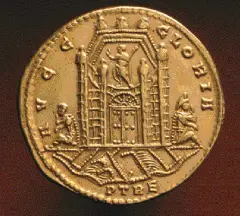
The Trier mint was established under Constantius Chlorus in 293; abbreviation P(ercussa) TRE(veri)
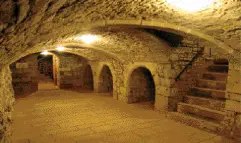
Intriguing: wine cellar from the 12th century under the floor of Constantine's throne room
Flavius Valerius Constantinus
Let us begin with this son, with Constantine. We know little about his youth, for Constantine, because of his illegitimate birth, evidently prohibited any written description of it. Thus we do not know his birth year. Even after Constantine’s death, Eusebius, his biographer, did not dare an exact mention of his age, as Constantine’s sons still lived and reigned. In his “official biography” from 337 to 339 directly after the Emperor’s death, Eusebius thus “hid” Constantine’s age in several places. Let us look at the last mention: Constantine “completed the time of his reign in two and thirty years, wanting a few months and days [July 25 to May 22 – 32 years according to Roman calculation; not quite 31 years, according to ours], … and his whole life extended to about twice that period” (VC [ Vita Constantini ] IV.53). From that, the age can be calculated as 2 x 32 minus 1 to 2 years, that is, 62 to 63 years. With a death date of May 22, 337, we would arrive at a birth year of 274 to 275. An age of 62 was already a great age, for a 60-year-old was already a senex , an old man. When we consider Constantine’s eventful life, that suggests immensely good health; indeed, Eusebius continues: “… At this age he still possessed a sound and vigorous body, free from all blemish” (VC IV.53). That was the inheritance from his mother Helena, who lived to be about 79 (VC III.46).
Читать дальше
